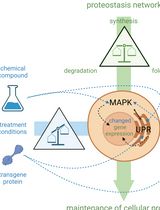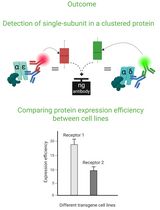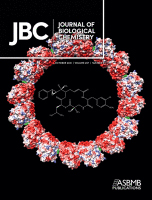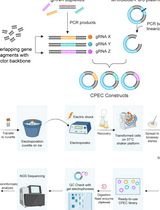- EN - English
- CN - 中文
Novel Protein Production Method Combining Native Expression in Human Cells with an Intein-based Affinity Purification and Self-cleavable Tag
将人类细胞中的天然表达与基于内含肽的亲和纯化和自切割标签相结合的新型蛋白质生产方法
发布: 2022年03月20日第12卷第6期 DOI: 10.21769/BioProtoc.4363 浏览次数: 2631
评审: Alessandro DidonnaMichael EnosNoelia Foresi

相关实验方案

Cell-Sonar:通过特定蛋白标志物表达变化追踪目标蛋白的简便低成本方法
Sabrina Brockmöller [...] Simone Rothmiller
2025年02月05日 1609 阅读

Cluster FLISA——用于比较不同细胞系蛋白表达效率及蛋白亚基聚集状态的方法
Sabrina Brockmöller and Lara Maria Molitor
2025年11月05日 1125 阅读
Abstract
The human proteins used in most biochemical studies are commonly obtained using bacterial expression. Owing to its relative simplicity and low cost, this approach has been extremely successful, but is inadequate for many proteins that require the mammalian folding machinery and posttranslational modifications (PTMs) for function. Moreover, the expressed proteins are typically purified using N- and/or C-terminal affinity tags, which are often left on proteins or leave non-native extra amino acids when removed proteolytically. Many proteins cannot tolerate such extra amino acids for function. Here we describe a protein production method that resolves both these issues. Our method combines expression in human Expi293F cells, which grow in suspension to high density and can process native PTMs, with a chitin-binding domain (CBD)-intein affinity purification and self-cleavable tag, which can be precisely removed after purification. In this protocol, we describe how to clone a target gene into our specifically designed human cell expression vector (pJCX4), and how to efficiently transfect the Expi293F cells and purify the expressed proteins using a chitin affinity resin.
Graphic abstract:

Background
The study of mammalian proteins in vitro often requires large amounts of pure proteins, which are typically expressed in bacteria and purified via the addition of N- and/or C-terminal affinity tags. These tags are often left on proteins or leave non-native extra amino acids when removed proteolytically (Waugh, 2011). The use of bacterial protein expression offers many advantages; it is a well-established system available in many laboratories, its adoption is relatively straightforward, and the overall cost of protein production is low. For these reasons, this will continue to be the method of choice for most applications. However, there are many cases in which bacterial expression is inadequate. A major disadvantage is the inability of bacteria to process posttranslational modifications (PTMs), which are often crucial for function (Brown et al., 2017). Even in cases where the role of PTMs is well established, they tend to be ignored, or their absence considered to be an unavoidable drawback of the method. Many mammalian proteins also have specific folding requirements that the bacterial expression system cannot account for (Rosano and Ceccarelli, 2014; Georgiou et al., 1994). The N- and C-termini of proteins are often important for function, such that many proteins cannot tolerate extra amino acids from purification tags at the ends (Brault et al., 1999; Wu and Filutowicz, 1999; Chant et al., 2005; Sliwinska et al., 2008; Suh-Lailam and Hevel, 2009). Here, we describe a method that resolves these concerns and can be broadly applied to protein expression. Our method combines expression in human Expi293F cells, which grow in suspension to high density and can process native PTMs, with a chitin-binding domain (CBD)-intein affinity purification and self-cleavable tag, which can be precisely removed after purification. The vector generated here to implement this method (pJCX4) has elements necessary to drive high protein expression in human cells, including the cytomegalovirus (CMV) promoter, the Woodchuck Hepatitis Virus (WHV) Posttranscriptional Regulatory Element (WPRE), and the Simian Virus 40 (SV40) PolyA sequence. This vector also supports cloning and plasmid production in E. coli, using the pUC origin of replication and the kanamycin resistance gene. Our goal here is to provide a detailed description of the method, to facilitate its adoption by new users. We have also deposited our vector with Addgene for the convenience of users that would like to adopt this method.
Materials and Reagents
Preparation of plasmid DNA
Polystyrene Petri dish, 10-cm (Stellar Scientific, catalog number: TC-WB-7452)
pJCX4 vector (Addgene, catalog number: 170756)
NEBNext High-Fidelity 2× PCR Master Mix (New England BioLabs, catalog number: M0541L)
SYBR Safe DNA Gel Stain (Thermo Fisher Scientific, Invitrogen, catalog number: S33102)
Tris base (Fisher Scientific, catalog number: BP152-500)
Glacial acetic acid (Millipore Sigma, catalog number: A6283-1L)
Ethylenediaminetetraacetic acid (EDTA) (Thermo Fisher Scientific, Invitrogen, catalog number: 15576028)
NucleoSpin Gel and PCR Cleanup, Mini kit for gel extraction and PCR clean up (Macherey-Nagel, catalog number: 740609.50)
NucleoSpin Plasmid, Mini kit for plasmid DNA (Macherey-Nagel, catalog number: 740588.50)
High-Fidelity restriction enzymes (New England BioLabs)
SeaKem Gold agarose (Lonza, catalog number: 50152)
Quick Ligation Kit (New England BioLabs, catalog number: M2200S)
XL-10 Gold competent cells (Agilent, catalog number: 200317)
LB Agar (Thermo Fisher Scientific, catalog number: 22700025)
Kanamycin monosulfate (Gold Biotechnology, catalog number: K-120-5)
PureLink HiPure Plasmid Filter Maxiprep Kit (Thermo Fisher Scientific, Invitrogen, catalog number: K210017)
0.5 M EDTA (see Recipes)
50× Tris-acetate-EDTA (TAE) (see Recipes)
1× TAE (see Recipes)
1% agarose gel with SYBR Safe DNA gel stain (see Recipes)
Expression in Expi293F Cells
125-mL and 500-mL polycarbonate, disposable, sterile, vent-cap Erlenmeyer shaker flasks (TriForest Labware, catalog numbers: FPC0125S and FPC0500S)
15-mL and 50-mL conical tubes (Fisher Scientific, Falcon, catalog numbers: 14-959-53A and 14-432-22)
10-mL serological pipettes (Corning, catalog number: 357551)
500-mL centrifuge bottles (Corning, catalog number: CLS431123-6EA)
Expi293F Expression System Kit (Thermo Fisher Scientific, Gibco, catalog number: A14635)
Expi293F Cells (Thermo Fisher Scientific, Gibco, catalog number: A14527)
Expi293F Expression Medium (Thermo Fisher Scientific, Gibco, catalog number: A1435102)
Opti-MEM Reduced-Serum Medium (Thermo Fisher Scientific, Gibco, catalog number: 31985070)
PEI MAX, Transfection Grade Linear Polyethylenimine Hydrochloride (Polysciences, catalog number: 24765-1)
Dulbecco’s Phosphate-Buffered Saline (PBS) (Thermo Fisher Scientific, catalog number: MT21031CV)
1 mg/mL PEI transfection reagent (see Recipes)
Purification of the intein-tagged protein
50-mL polycarbonate bottles with caps (Beckman Coulter, catalog number: 361693)
Chitin affinity resin (New England BioLabs, catalog number: S6651S)
KONTES chromatography Flex-Column (Avantor, VWR, catalog number: KT420401-2510)
HEPES (Gold Biotechnology, catalog number: H-400-1)
Sodium Chloride (NaCl) (Thermo Scientific, catalog number: J21618-A9)
DL-Dithiothreitol (DTT) (Gold Biotechnology, catalog number: DTT100)
Phenylmethylsulfonyl fluoride (PMSF) (Gold Biotechnology, catalog number: P-470-25)
β-mercaptoethanol (βME) (Santa Cruz Biotechnology, catalog number: sc-202966)
Adenosine-5’-triphosphate (ATP) (Gold Biotechnology, catalog number: A-081-1)
Coomassie Brilliant Blue R-250 (Gold Biotechnology, catalog number: C-461-5)
Methanol (Ibis Scientific, catalog number: MX0486-1)
Acetic acid (Ibis Scientific, catalog number: CP-M1010S)
12% acrylamide SDS-PAGE gels (Bio-Rad, catalog number: 4561046)
Coomassie stain solution for acrylamide gels (see Recipes)
Lysis buffer (see Recipes)
ATP wash buffer (see Recipes)
Intein cleavage buffer (see Recipes)
Equipment
Preparation of plasmid DNA
PTC-200 thermocycler (MJ Research, catalog number: MJ-G200)
Horizontal electrophoresis system (Fisherbrand, catalog number: FB-SBR-2025)
Eppendorf tabletop centrifuge (Eppendorf, catalog number: EP-5415D)
Water bath (Thomas Scientific, Humboldt, catalog number: 1196X13)
Imperial-III 37°C incubator (Lab-Line, catalog number: 305)
QIArack (Qiagen, catalog number: 19015)
Expression in Expi293F Cells
Isotemp CO2 Incubator (Fisherbrand, catalog number: 11-676-604)
CO2 resistant orbital shaker (Thermo Scientific, catalog number: 88881101)
Biological safety cabinet (Fisher Scientific, catalog number: 13-261-222)
Refrigerated benchtop centrifuge (Beckman Coulter, model: Allegra X-15R)
Purification of the intein-tagged protein
Dounce glass piston homogenizer (VWR, Kontes Glass, catalog number: KT885300-0040)
Beckman Avanti J-20-I centrifuge (Beckman Coulter, catalog number: 8043-30-1169)
JA25.50 rotor (Beckman Coulter, catalog number: 363055)
Peristaltic pump (Bio-Rad, catalog number: 7318140)
SDS-PAGE gel running apparatus (Bio-Rad, catalog number: 1658025FC)
Procedure
文章信息
版权信息
© 2022 The Authors; exclusive licensee Bio-protocol LLC.
如何引用
Readers should cite both the Bio-protocol article and the original research article where this protocol was used:
- Carman, P. J. and Dominguez, R. (2022). Novel Protein Production Method Combining Native Expression in Human Cells with an Intein-based Affinity Purification and Self-cleavable Tag. Bio-protocol 12(6): e4363. DOI: 10.21769/BioProtoc.4363.
- Carman, P. J., Barrie, K. R. and Dominguez, R. (2021). Novel human cell expression method reveals the role and prevalence of posttranslational modification in nonmuscle tropomyosins. J Biol Chem 297(4): 101154.
分类
生物化学 > 蛋白质 > 表达
分子生物学 > DNA > DNA 克隆
您对这篇实验方法有问题吗?
在此处发布您的问题,我们将邀请本文作者来回答。同时,我们会将您的问题发布到Bio-protocol Exchange,以便寻求社区成员的帮助。
Share
Bluesky
X
Copy link









